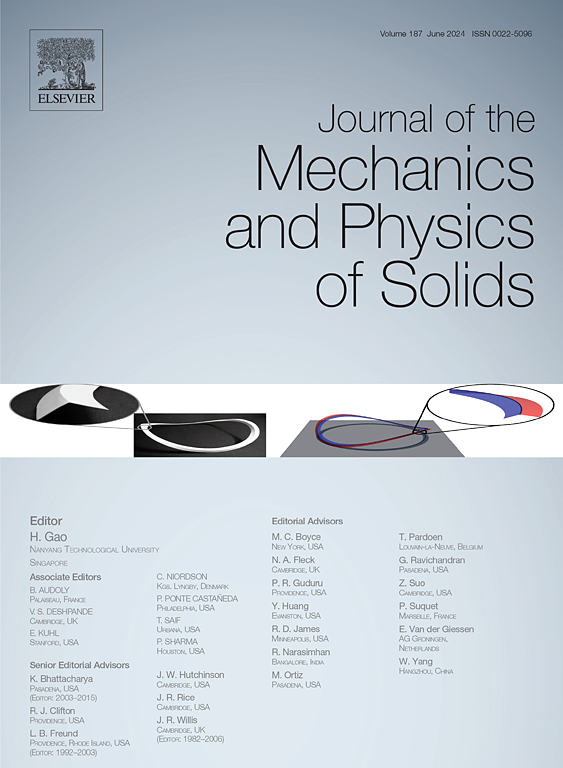极端压缩下软弹性球的非线性接触力学
IF 6
2区 工程技术
Q2 MATERIALS SCIENCE, MULTIDISCIPLINARY
引用次数: 0
摘要
软弹性球在基板上的接触是一个与生物工程、机器人、微装配和可穿戴设备等领域有重要关系的基本问题。在极端压缩下,特别是在压缩比(压缩位移按球半径归一化)超过10%时,接触行为的精确解析解仍然缺乏。本研究结合理论分析、有限元分析(FEA)模拟和实验,探讨了弹性球在大变形下与刚性基板的接触力学(即扁化问题)。考虑有限厚度和径向膨胀效应,提出了扁化问题的有限变形理论框架。这个框架有利于接触力、接触半径和接触压力的分析解决方案。系统分析非线性的三个主要来源——几何、材料和接触特性——揭示几何非线性是导致接触力偏离赫兹理论的主要因素。基于这些见解,使用简单的线性修正函数获得了接触力、接触半径和接触压力的显式解,与有限元结果非常吻合。用Ecoflex样品进行的实验验证表明,在压缩比高达80%的情况下,这些溶液具有很高的准确性。此外,它们对细胞力学的适用性通过文献报道的各种细胞类型在高达75%的压缩比下接触力的精确预测得到验证。这项工作提供了一个有效的方法来解决非线性扁化问题,使接触行为在极端压缩下的准确预测。我们的发现为涉及软弹性体的接触分析和结构设计提供了有价值的指导。本文章由计算机程序翻译,如有差异,请以英文原文为准。
Nonlinear contact mechanics of soft elastic spheres under extreme compression
The contact of soft elastic spheres on substrates is a fundamental problem with significant relevance to fields such as bioengineering, robotics, micro-assembly, and wearables. Accurate analytical solutions for contact behaviors under extreme compression, particularly at compression ratios (compression displacement normalized by sphere radius) exceeding 10 %, are still lacking. This study investigates the contact mechanics of an elastic sphere against a rigid substrate (i.e., the flattening problem) under large deformations, integrating theoretical analysis, finite element analysis (FEA) simulations, and experiments. A finite-deformation theory framework for the flattening problem is proposed, accounting for finite-thickness and radial expansion effects. This framework facilitates analytical solutions for contact force, contact radius, and contact pressure. Systematic analysis of the three key sources of nonlinearity—geometry, material, and contact properties—reveals that geometric nonlinearity is the primary factor causing deviations in contact forces from the Hertzian theory. Based on these insights, explicit solutions for contact force, contact radius, and contact pressure are obtained using simple linear correction functions, achieving excellent agreement with FEA results. Experimental validation with Ecoflex samples demonstrates the high accuracy of these solutions at compression ratios up to 80 %. Additionally, their applicability to cellular mechanics is validated through precise predictions of contact forces reported in the literature for various cell types at compression ratios up to 75 %. This work provides an effective approach to addressing nonlinearities in the flattening problem, enabling accurate predictions of contact behavior under extreme compression. Our findings offer valuable guidelines for contact analysis and structural design involving soft elastomers.
求助全文
通过发布文献求助,成功后即可免费获取论文全文。
去求助
来源期刊
CiteScore
9.80
自引率
9.40%
发文量
276
审稿时长
52 days
期刊介绍:
The aim of Journal of The Mechanics and Physics of Solids is to publish research of the highest quality and of lasting significance on the mechanics of solids. The scope is broad, from fundamental concepts in mechanics to the analysis of novel phenomena and applications. Solids are interpreted broadly to include both hard and soft materials as well as natural and synthetic structures. The approach can be theoretical, experimental or computational.This research activity sits within engineering science and the allied areas of applied mathematics, materials science, bio-mechanics, applied physics, and geophysics.
The Journal was founded in 1952 by Rodney Hill, who was its Editor-in-Chief until 1968. The topics of interest to the Journal evolve with developments in the subject but its basic ethos remains the same: to publish research of the highest quality relating to the mechanics of solids. Thus, emphasis is placed on the development of fundamental concepts of mechanics and novel applications of these concepts based on theoretical, experimental or computational approaches, drawing upon the various branches of engineering science and the allied areas within applied mathematics, materials science, structural engineering, applied physics, and geophysics.
The main purpose of the Journal is to foster scientific understanding of the processes of deformation and mechanical failure of all solid materials, both technological and natural, and the connections between these processes and their underlying physical mechanisms. In this sense, the content of the Journal should reflect the current state of the discipline in analysis, experimental observation, and numerical simulation. In the interest of achieving this goal, authors are encouraged to consider the significance of their contributions for the field of mechanics and the implications of their results, in addition to describing the details of their work.

 求助内容:
求助内容: 应助结果提醒方式:
应助结果提醒方式:


